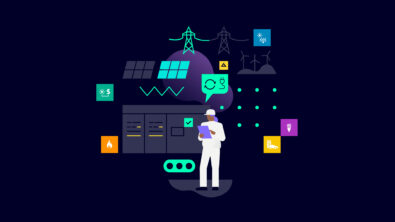The digital twin can direct the sustainable transformation of aviation

Climate change is one of the biggest concerns for the aviation industry, with commercial aviation contributing approximately 4.9% of total global fossil fuel emissions. That may sound small, but it is still 1.9 billion tons of CO2 emitted each year. As a result, companies are investigating ways to reduce aircraft emissions and increase fuel efficiency to meet the goal of carbon neutrality by 2050, as set by the Paris Agreement. That said, the industry today is heavily reliant on fossil fuels, and using conventional methods, companies may not be able to meet that goal in time. The digital twin, however, can help them navigate risks and quicken the transition toward carbon neutrality.
Aviation today
Contemporary commercial aircraft have remained largely the same since the 1950s, utilizing jet engines to combust fossil fuels like kerosene due to their high energy density. Even as the awareness of fossil fuels’ negative impact on the environment increased over the decades, there was not an alternative option present that could match the high energy density of fossil fuels. Jet engines may have become more efficient and less pollutive since the 1950s, but as climate change worsens, it is becoming clear companies need a sustainable alternative.
Ensuring the aviation industry meets the terms of the Paris Agreement will require a massive transformation across the whole industry to accommodate alternative energy sources like batteries and hydrogen. These energy sources will require major alterations to aircraft and aviation infrastructure to support them, but the digital twin can provide invaluable assistance in carrying out those alterations successfully.
Navigating the transformation
Electric batteries and hydrogen fuel are both favorable options for powering green aviation, but each also have their own advantages and drawbacks. Batteries lack direct emissions entirely as they rely on stored electricity to power aircraft. However, they are very heavy and their energy density is notoriously low, making them unideal for larger aircraft like passenger liners. Meanwhile, hydrogen fuel has higher energy density than even fossil fuels like kerosene and produces only water when combusted. That said, hydrogen is very difficult to store, requiring larger containment units capable of preventing hydrogen gas from escaping or advanced cryogenic systems to store it in liquid form. Both options offer potential for achieving widespread sustainable flight, but each have critical obstacles to overcome.
Surmounting these obstacles will require not just changes in the configuration of individual aircraft, but also a radical transformation across the whole aviation industry. Aircraft configurations will need to change to account for the storage of sustainable energy, whether through the addition of batteries or hydrogen fuel cells or shifting to a blended wing configuration to increase fuselage space for storing hydrogen fuel. Both ideas, however, would require further changes to aircraft design, like passenger capacity and positioning to accommodate these new energy sources. Additionally, ground-based infrastructure like airports will need to be able to support these new energy sources, such as by building charging stations for battery-powered aircraft or storage facilities for hydrogen. Every one of these changes will come with their own challenges that will need to be addressed in order for zero emission aircraft to become the norm.
The need for the digital twin
The digital twin can be instrumental in making sure companies can overcome these challenges quickly while saving money in the process. As a virtual representation of a product, the digital twin provides an integrated design environment for multi-disciplinary aerospace engineering teams. Here, engineers can model, test, and analyze the impact of alternative energy sources on new aircraft configurations from the component level to an entire integrated aircraft. This will let engineers optimize their designs and make vital engineering decisions early, allowing sustainable aircraft to take to the skies faster while saving resources that would otherwise be used for extensive testing and prototyping.
The same technology can also be used to help transform the aviation industry’s infrastructure. By determining what new sustainable aircraft configurations will require earlier, that data can then be used to better strategize the supply chains and build the necessary support structures for aircraft. This way, by the time the new sustainable aircraft are ready to be rolled out, airports and hangars will already have what they need to provide support, launching the next generation of aviation with less risk.
Toward a greener future
Transforming the aviation industry to become more sustainable is both exciting and daunting. Alternative energy sources like electric batteries and hydrogen fuels have great potential to benefit the world but come with challenges that require massive transformations to individual aircraft and the industry as a whole. Fortunately, the digital twin can provide companies the ability to navigate challenges early and effectively and bring these transformations into reality sooner. With technology and tenacity, the aviation world can be successfully transformed, making our skies cleaner and brighter.
To learn more about the digital twin’s role in achieving sustainable aviation, check out any of the assets below.
- “Shaping sustainable aviation with a digital twin” – White Paper & Video
- “Paving the way to sustainable aviation by 2050” – White Paper
- “Empower sustainable aviation with digital twins” – Webinar
Siemens Digital Industries Software helps organizations of all sizes digitally transform using software, hardware and services from the Siemens Xcelerator business platform. Siemens’ software and the comprehensive digital twin enable companies to optimize their design, engineering and manufacturing processes to turn today’s ideas into the sustainable products of the future. From chips to entire systems, from product to process, across all industries, Siemens Digital Industries Software is where today meets tomorrow.


